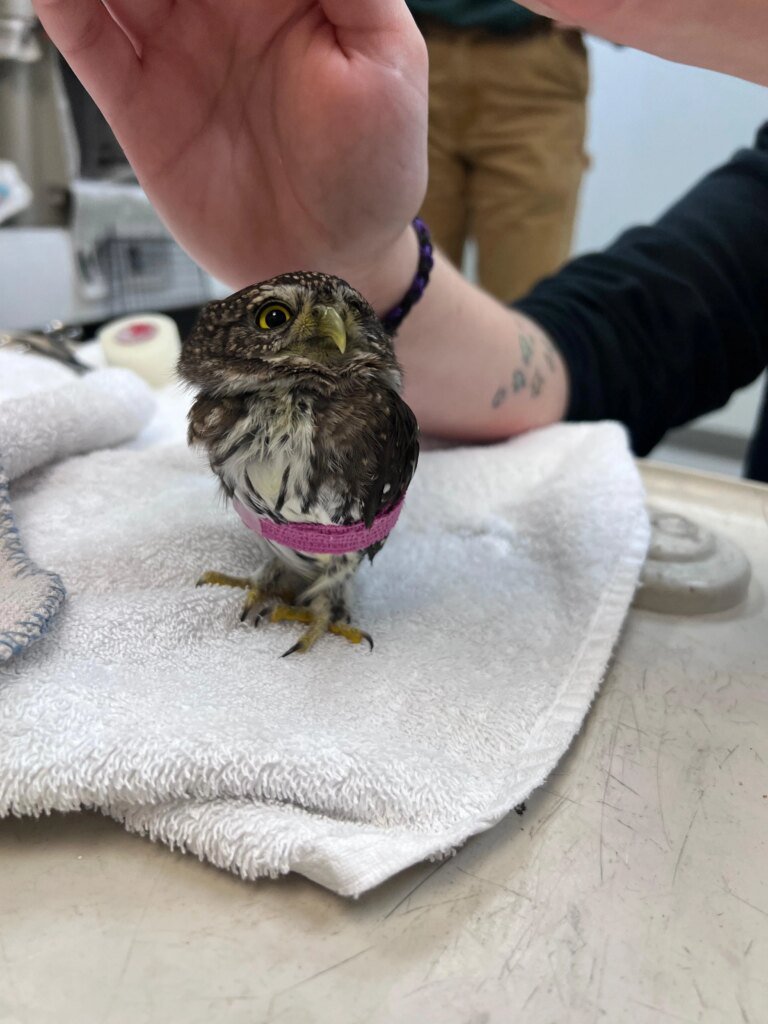Situated on southeast Alaska’s scenic Baranof Island, the Alaska Raptor Center in Sitka mainly treats the region’s signature bald eagles. These large birds of prey are almost three feet tall and their wingspan is over 6 feet—so one can only imagine how striking it must have been when the staff received a sparrow-sized northern pygmy-owl–Alaska’s smallest owl species.
“Getting in an owl this tiny is always a challenge! Our enclosures are all designed for larger birds!” Jennifer Cedarleaf, the center’s Avian Director, tells Popular Science. “We will take any bird that is in need of help. So, while this tiny owl is unusual for us, we are here to help care for birds with injuries and try our best to get them back into their natural habitat.”
The tiny predator was found by his rescuers, when he was sitting in their yard in the city of Ketchikan with his left wing out. They named him King Owlbert, and faced an instant dilemma. They couldn’t just drive his majesty from Ketchikan to the Alaska Raptor Center in Sitka.The cities are on two different islands with no driveable connection. Instead, King Owlbert took a 40 minute flight aboard Alaska Airlines.
[ Related: Why a ‘donut’ can help injured birds. ]
Since northern pygmy-owls can stress rapidly, Cedarleaf was nervous about the trip. The center instructed the rescuers to put King Owlbert in a kennel with all its windows and doors covered with cardboard poked with holes. This allows for airflow, while keeping the kennel dark and with low visibility, which helps keep raptors calm.
Upon arrival, King Owlbert was healthy, but a bit thin, weighing 52 grams (roughly two ounces). Northern pygmy-owls typically weigh 60 to 70 grams or about two ounces. Since his arrival, the team has been feeding him mice, and the consistent diet has fattened him up to 57 grams, which is about equivalent to the weight of 23 pennies.

“Since he has a wing droop, we have been wrapping his wing in what is called a figure-8 bandage. This bandage wraps around his wing and then continues around his chest, under his good wing, giving the injured wing support,” Cedarleaf explained. “One of the things we are worried about with his droopy wing is that he will break the flight feathers and that will increase the amount of time he is with us.”
Cedarleaf and her colleagues believe that the tiny predator may have flown into a window and injured his wing. Given that they didn’t identify any broken bones, King Owlbert might be suffering from a soft tissue injury.
“We are treating his wing with cold laser therapy to help increase blood flow to the wing and aid in healing,” Cedarleaf said, adding that the most difficult aspect of this adorable patient’s care is his tiny size. “We are also doing some physical therapy to keep his joints moving. We are very hopeful that his injury will resolve with time and we can release him back to his natural habitat.”



